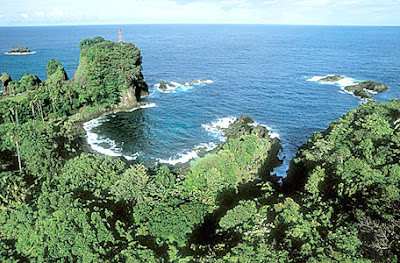Ujung Kulon National Park is representative of tropical rain forest ecosystem remaining lowland and the largest in West Java, now Banten, and is an ideal habitat for the survival of endangered Javan rhinoceros (Rhinoceros sondaicus) and other rare animals. There are three types of ecosystems in national parks is the aquatic ecosystem of sea, marsh ecosystems, and terrestrial ecosystems.
Diversity of plants and animals in Ujung Kulon National Park began to be known by the researchers, botanists Netherlands and the UK since 1820.
Diversity of plants and animals in Ujung Kulon National Park began to be known by the researchers, botanists Netherlands and the UK since 1820.
Approximately 700 species of plants is well protected and 57 of them rare species such as merbau (Intsia bijuga), palahlar (Dipterocarpus haseltii), Bungur (Lagerstroemia speciosa), luminous (Pterospermum diversifolium), ki rain (Engelhardia serrata) and various species of orchid .
Initially Ujung Kulon is an agricultural area in some time until finally destroyed and depleted its entire population when Krakatoa erupted on August 27, 1883 which ultimately convert the area back to forest.
Animals in Ujung Kulon National Park consists of 35 species of mammals, 5 species of primates, 59 species of reptiles, 22 species of amphibians, 240 species of birds, 72 species of insects, 142 species of fish and 33 species of coral. Endangered and protected animals other than Java rhinoceros is the banteng (Bos javanicus javanicus), ajag (Cuon alpinus javanicus), Javan (Presbytis Comata Comata), langur (Trachypithecus auratus auratus), deer (Cervus russa timorensis), leopard (Panthera pardus), cats rock (Prionailurus javanensis bengalensis), gibbon (Hylobates moloch), and giant clam (Tridacna gigas).
Ujung Kulon National Park is an interesting natural attractions, the beauty and uniqueness of various forms of natural phenomena in the form of a jeramnya rivers, waterfalls, white sand beaches, hot springs, marine parks and cultural heritage / history (Ganesha statue, Mount Panaitan Mercury Island). They are all natural charm of a very interesting place to visit and hard to find elsewhere.
Species of interest in Ujung Kulon National Park, both living in the sea or rivers, among others, butterfly fish, clown, angel, lion, parrot, glodok and chopsticks. Fish and fish glodok chopsticks are two types of fish are very strange and unique that glodok fish have the ability to climb trees, while the fish chopsticks have the ability to spray water over a height of more than one meter to shoot prey (insects) in the i the leaves of the branches protrude above the water surface.
Ujung Kulon National Park with Krakatau Nature Reserve is a national asset, and has been designated as a World Natural Heritage Site by UNESCO in 1991.
To improve the management of Ujung Kulon National Park as a World Natural Heritage Site, UNESCO has provided funding support and technical assistance.
To improve the management of Ujung Kulon National Park as a World Natural Heritage Site, UNESCO has provided funding support and technical assistance.
Communities living around the national park is famous for its tribal Bantam Debus art that is not subject to sharps injuries and heat-resistant flame. Communities that still retain the customs, traditions, and culture of their ancestors.
Inside the park, there are places sacred to the interests of different religious beliefs. The most famous place as a pilgrimage destination is the cave Biosciences Sirah, which is located on the western tip of peninsula of Ujung Kulon.
Inside the park, there are places sacred to the interests of different religious beliefs. The most famous place as a pilgrimage destination is the cave Biosciences Sirah, which is located on the western tip of peninsula of Ujung Kulon.






